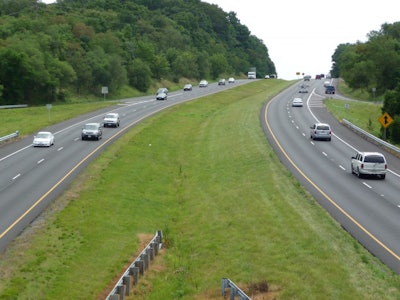
The Reason Foundation’s 22nd Annual Highway Report tracks the performance of the 50 state-owned highway systems. States are ranked in 11 categories including Interstate and rural primary road pavement conditions, deficient bridges, traffic congestion, fatality rates, unsafe narrow rural arterial lanes, capital costs per mile, administrative costs per mile, maintenance costs per mile and total highway expenditures per mile.
The study is based on spending and performance data that state highway agencies provided to the federal government for 2013, with the exception of traffic congestion data. The Federal Highway Administration (FHWA) is no longer publishing the traffic congestion data used in previous editions of the Annual Highway Report. As a result, this edition uses 2014 traffic congestion data from the Texas A&M Transportation Institute.
Although individual highway sections (roads, bridges, pavements) steadily deteriorate over time due to age, use, traffic and weather, they are also periodically improved by maintenance and reconstruction. As a result, system performance can improve even as individual roads and bridges deteriorate.
While bridge conditions and fatality rates continued to improve, the overall condition of the U.S. state-owned highway system worsened slightly from 2012 to 2013. From 2012 to 2013, total revenues for state-administered highways increased almost 5%. Nationally, however, expenditures for capital and bridges, maintenance and administration all dropped, possibly as states reduced outlays while waiting for federal action on a long-term transportation bill.
The passage of the five-year federal transportation Fixing America’s Surface Transportation (FAST) Act passed and signed in 2015, may have added long-term certainty and additional funding to transportation. There is no guarantee, however, that states will spend the additional money wisely in the coming years.
South Carolina tops the Annual Highway Report’s overall cost-effectiveness ratings for the first time since 1995. South Carolina has been a consistent top performer, ranking in the top 10 since 2003. South Dakota, Kansas, Nebraska and Maine round out the top five in the overall rankings. While smaller, more-rural states make up the top five, several large urban states (Ohio—9, Missouri—12, North Carolina—15, and Texas—19) are ranked in the top 20 overall. At the bottom of the overall rankings are Alaska, New Jersey, Hawaii, Rhode Island and Massachusetts.
Other findings in the report include:
- 50% of the nation’s rural Interstate mileage in poor condition can be found in just five states: Alaska, California, Colorado, Washington and Indiana
- 48% of the country’s urban Interstate mileage rated in poor condition is in five states: California, New York, Texas, Michigan and Louisiana
- 54% of the rural primary mileage in poor condition is in five states: Alaska, Iowa, Minnesota, Texas and Wisconsin
- Traffic congestion in eight states (New Jersey, New York, California, Virginia, Maryland, Massachusetts, Illinois and Washington) causes over 50 hours of delay annually per auto commuter
- Although bridge conditions are steadily improving, six states (Massachusetts, Connecticut, New York, Pennsylvania, Rhode Island and Hawaii) report more than one-third of their bridges as deficient
- Fatality rates continue to improve, but four states (South Carolina, Mississippi, West Virginia and Montana) have fatality rates greater than 1.5 per 100 million vehicle-miles
- Four states (West Virginia, Virginia, Pennsylvania and Vermont) report that more than one-third of their rural principal arterial roads have narrow lanes that may be unsafe for today’s vehicle
According to the report, there seems to be a widening performance gap emerging between most states that are making progress and a few states that are finding it difficult to improve. There is also increasing evidence that higher-level road systems (Interstates, other freeways and principal arterials) are in better shape than lower-level road systems, particularly local roads.
To see the complete report and where your state ranks, click here.















